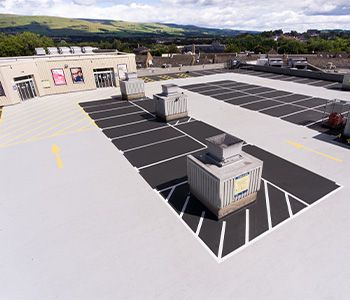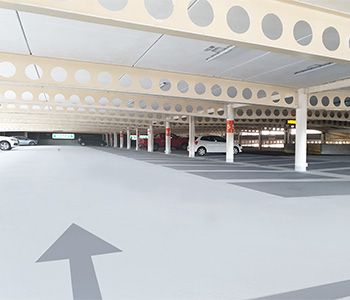With over 38 years in the waterproofing, surfacing and protection of car parks, Triflex has seen a lot of change. Here, Richard Bowyer, National Sales Manager at Triflex talks about the new challenges that climate change is bringing and what that might mean for new build and multi-storey car park refurbishment projects.
Car park building methods may have developed over time, but cast in situ concrete, composite and metal shuttering constructed car parks are found across our towns, cities and workplaces. The waterproofing and protection of these concrete forms continues to be recognised as vital in maintaining the integrity of these hard working and revenue generating structures.
The effects of rising temperatures
Multi-storey top decks are the obvious place to start when waterproofing a car park. Historically, materials have included asphalt, polyurethane, or other coatings. In the last few decades that has changed to an increase in polymer modified asphalt and the growing preference for polymethyl methacrylate (PMMA) systems. Climate change effects such as last summer’s unprecedented 40 degrees are seen by many as a taste of things come. In very hot temperatures, the asphalt surface can become soft and sticky. Warnings were issued to avoid travel during the extreme heat, with some citing melting roads, pavements and car parks. A direction which may see less asphalt coated car park top decks of newly built multi-storey car parks in the future.
Reducing urban island heat island effects with surface colour
The colour of a car park surface can contribute locally to higher temperatures due to heat radiation. Thanks to high UV stability, pigmented PMMA retain their colours and finishes over time. That means that lighter colours are now appearing on car park surfaces. A mid or light grey will absorb less of the sun’s radiation than a black or dark surface, reducing any urban heat island effect of the building. The UK’s car parks haven’t quite embraced the white roads currently trialling in Los Angeles, but it will be interesting to see if this emerging trend makes an impact here.
The changing environment and structural movement
It’s important to consider the changing environment on the movement of the structure too. Cracks in existing car park surfaces need attention, or prevention in new build car park structures. Any cracks can allow water ingress and corrosive salts to penetrate, leading to steel reinforcement corrosion and structural damage. Car parks are designed to move, so elastomeric waterproofing systems are required to move with them. Waterproofing and surfacing systems certified to the highest level, such as class B4.2 (-20°C) for dynamic crack bridging under EN 1504-2, deliver peace of mind for concrete protection. With heavier electric vehicles set to dominate, and more extreme temperatures, it seems prudent to consider this a must for future car park protection.
Consideration for changing weather patterns
Technologically advanced PMMA resins can also facilitate winter working. The ability of some to cure at 0°C or even -5°C means that they are less restricted by winter temperatures. In decades past, summer was the preferred time of year for waterproofing and surfacing projects. Now, due to a combination of more advanced resins and shifting weather patterns, car park waterproofing, surfacing and protection projects are increasingly undertaken in the spring, autumn or early winter. According to the Met Office, our weather is getting warmer and wetter. Where some PMMA resins are rainproof in just 30 minutes, short weather windows in wetter months can be optimised. That’s good to know as this type of weather is predicted to increase.
Environmental changes driving trends in specification
Interior car park decks and ramps also need protection and waterproofing. The concrete surfaces here are at the mercy of corrosive road salts which are driven into the car parks on the vehicles that use them. Commonly more is dropped from vehicles at the lower levels, closer to pedestrian exits and centre access points. Of course, water ingress from upper levels can also contribute to structural damage. A wetter climate also means heavier rainfall which may mean closer attention to drainage channels and waterproofing detailing. Heavier vehicles also exert greater forces, and this can be evident on the ramps and turning points in the car park’s busiest driving aisles. This has seen a trend in specifying greater levels of anti-skid such as those that incorporate emery.
With the only certainty predicted one of change, experience in car park protection and an understanding of the car park structures can go a long way to future proofing the waterproofing, protection and surfacing of a multi-storey car park. Take advantage of our know-how to see how we can help protect your car park from an uncertain climate future.


